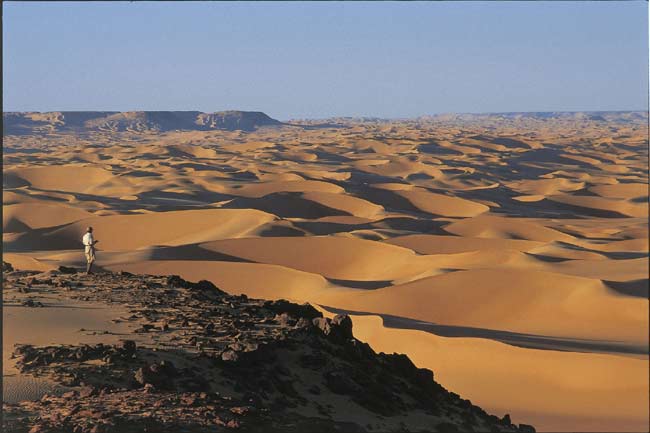Sahara Desert Was Once Lush and Populated

At the end of the last Ice Age, the Sahara Desert was just as dry and uninviting as it is today. But sandwiched between two periods of extreme dryness were a few millennia of plentiful rainfall and lush vegetation.
During these few thousand years, prehistoric humans left the congested Nile Valley and established settlements around rain pools, green valleys, and rivers.
The ancient climate shift and its effects are detailed in the July 21 issue of the journal Science.
When the rains came
Some 12,000 years ago, the only place to live along the eastern Sahara Desert was the Nile Valley. Being so crowded, prime real estate in the Nile Valley was difficult to come by. Disputes over land were often settled with the fist, as evidenced by the cemetery of Jebel Sahaba where many of the buried individuals had died a violent death.
But around 10,500 years ago, a sudden burst of monsoon rains over the vast desert transformed the region into habitable land.
This opened the door for humans to move into the area, as evidenced by the researcher's 500 new radiocarbon dates of human and animal remains from more than 150 excavation sites.
Get the world’s most fascinating discoveries delivered straight to your inbox.
"The climate change at [10,500 years ago] which turned most of the [3.8 million square mile] large Sahara into a savannah-type environment happened within a few hundred years only, certainly within less than 500 years," said study team member Stefan Kroepelin of the University of Cologne in Germany.
Frolicking in pools
In the Egyptian Sahara, semi-arid conditions allowed for grasses and shrubs to grow, with some trees sprouting in valleys and near groundwater sources. The vegetation and small, episodic rain pools enticed animals well adapted to dry conditions, such as giraffes, to enter the area as well.
Humans also frolicked in the rain pools, as depicted in rock art from Southwest Egypt.
In the more southern Sudanese Sahara, lush vegetation, hearty trees, and permanent freshwater lakes persisted over millennia. There were even large rivers, such as the Wadi Howar, once the largest tributary to the Nile from the Sahara.
"Wildlife included very demanding species such as elephants, rhinos, hippos, crocodiles, and more than 30 species of fish up to 2 meters (6 feet) big," Kroepelin told LiveScience.
A timeline of Sahara occupation [See Map]:
- 22,000 to 10,500 years ago: The Sahara was devoid of any human occupation outside the Nile Valley and extended 250 miles further south than it does today.
- 10,500 to 9,000 years ago: Monsoon rains begin sweeping into the Sahara, transforming the region into a habitable area swiftly settled by Nile Valley dwellers.
- 9,000 to 7,300 years ago: Continued rains, vegetation growth, and animal migrations lead to well established human settlements, including the introduction of domesticated livestock such as sheep and goats.
- 7,300 to 5,500 years ago: Retreating monsoonal rains initiate desiccation in the Egyptian Sahara, prompting humans to move to remaining habitable niches in Sudanese Sahara. The end of the rains and return of desert conditions throughout the Sahara after 5,500 coincides with population return to the Nile Valley and the beginning of pharaonic society.
Related Stories
